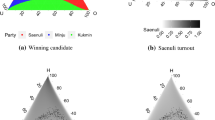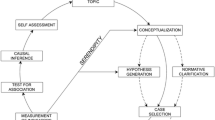Abstract
Some people are influenced by other people who live near them. They vote for the same political party as their neighbours and they go to church on Sunday because that is what most other people in the area do. This phenomenon is known as the compositional effect of the environment. This article offers a survey of the history of the analysis of such effects, of the explanations that can be given for them and of the research methods that can be used to establish them. The most important conclusions regarding political preference are given, and a direction in which research into compositional effects should develop is also indicated.
Similar content being viewed by others
References
Agnew, J.: Mapping politics: how context counts in electoral geography. In: Political Geography 15, 129–146 (1996).
Banaszak, L. A.; Leighley, J. E.: How employment affects women's gender attitudes. In: Political Geography Quarterly 10, 110–131 (1991).
Barton, A.: Comments on Hauser's ‘Context and Consex’. In: American Journal of Sociology 76, 514–517 (1970).
Berelson, B. R.; Lazarsfeld, P. F.; McPhee, W. H.: Voting; A study of opinion formation in a presidential campaign. Chicago, The University of Chicago Press, (1954).
Blau, P. M.: Structural effects. In: American Sociological Review 25, 178–193 (1960).
Books, J. W.; Prysby, Ch. L.: Political Behavior and the Local Context. New York, Praeger Publishers, (1991).
Cox, K. R.: Suburbia and Voting Behavior in the London Metropolitan Area. In: Annals of the Association of American Geographers 58, 111–127 (1968).
Cox, K. R.: The Voting Decision in a Spatial Context. In: C. Board, R.J. Chorley & P. Haggett, eds. Progress in Geography, 81–117. London, Edward Arnold, (1969).
Cox, K. R.: The neighborhood Effect in Urban Voting Response Surfaces. In: David C. Sweet, eds.Models of Urban Structure, 159–176. Lexington, Massachusetts, D.C. Heath and Company, (1972).
Davis, J. A., Spaeth, J. L.; Huson, C.: A technique for analyzing the effects of group composition. In: American Sociological Review 26, 215–225 (1961).
Eagles, M.: An ecological perspective on workingclass political behaviour: neighbourhood and class formation in Sheffield. In: Johnston, R.J., F.M. Shelley & P.J. Taylor (eds). Developments in Electoral Geography; 100–120. London/New York, Routledge, (1990).
Ennis, Ph. H.: The Contextual Dimension in Voting. In: William N. McPhee & William A. Glaser (eds). Public Opinion and Congressional Elections; 180–211. The Free Press of Glencoe, (1962).
Farkas, G.: Specification, residuals and contextual effects, Sociological Methods and Research 2, 333–363, (1974).
Foladare, I. S.: The Effect of Neighborhood on Voting Behavior. In: Political Science Quarterly 83, 516–529, (1968).
Giggs, J.A.: The distribution of schizophrenics in Nottingham. In: Transactions of the Institute of British Geographers 59, 55–76, (1973).
Goldstein, H. Multilevel Models in Educational and Social Research. New York, Oxford University Press, (1987).
Grogger, J.; Weatherford, M. St.: Crime, policing and the perception of neighborhood safety. In: Political Geography 14, 521–541, (1995).
Hauser, R. M.: Context and Consex: A Cautionary Tale. In: American Journal of Sociology 75, 645–664, (1970).
Hauser, R. M.: Contextual analysis revisited. In: Sociological Methods and Research 2, 365–375, (1974).
Honey, R.; Barnett, J. R.: Volatile stability: New Zealand's 1987 general election. In: Johnston, R.J., F.M. Shelley & P.J. Taylor (eds). Developments in Electoral Geography; 86-99. London/ New York, Routledge, (1990).
Johnston, R. J.: Contagion in neighbourhoods: a note on problems of modelling and analysis. In: Environment and Planning A 8, 581–585, (1976).
Johnston, R. J.: The Neighbourhood Effect Won't Go Away: Observations on the Electoral Geography of England in the Light of Dunleavy's Critique. In Geoforum 14, 161–168, (1983).
Johnston, R. J.: The Geography of English Politics. London, Croom Helm, (1985).
Johnston, R. J.: The neighbourhood effect revisited: spatial science or political regionalism. In: Environment and Planning D 4, 41–55, (1986a).
Johnston, R. J.: Information Provision and Individual Behavior: A Case Study of Voting at an English General Election. In: Geographical Analysis 18, 129–141, (1986b).
Johnston, R. J.: The geography of the working class and the geog-raphy of the Labour vote in England, 1983. In: Political Geography Quarterly 6, 7–16, (1987).
Johnston, R. J.: Lipset and Rokkan revisited: electoral cleavages, electoral geography, and electoral strategy in Great Britain. In: Johnston, R.J., F.M. Shelley & P.J. Taylor (eds). Developments in Electoral Geography; 121–142. London/New York, Routledge, (1990).
Jones, K.: Multi-Level Models for Geographical Research. CATMOG 54. Norwich, University of East Anglia, (1991).
Jones, K.: 'Everywhere is Nowhere': Multilevel Perspectives on the Importance of Place. The University of Portsmouth Inaugural Lectures, (1993).
Jones, K.: Multilevel approaches to modelling contextuality: from nuisance to substance in the analysis of voting behaviour. In: G.P. Westert & R.N. Verhoeff (eds). Places and people: multilevel modelling in geographical research. Utrecht, The Royal Dutch Geographical Society, (1997).
Kendall, P. L.; Lazarsfeld, P. F.: Problems of Survey Analysis. In: Robert K. Merton and Paul F. Lazarsfeld (eds). Continuities in Social Research: Studies in the Scope and Method of ‘The American Soldier’; 133–196. Glencoe, The Free Press, (1950).
King, G.: Why context should not count. In: Political Geography 15, 159–164, (1996).
Knippenberg, H.; de Vos, S.: Spatial Structural Effects on Dutch Church Attendance. In: Tijdschrift voor Economische en Sociale Geografie 80, 164–170, (1989).
Kreft, G. G.: Models and Methods for the Measurement of School Effects. Utrecht, Elinkwijk, (1987).
Laponce, J. A.: Assessing the neighbour effect on the vote on francophone minorities in Canada. In: Political Geography Quarterly 6, 77–87, (1987).
Lazarsfeld, P. F.: Problems in Methodology. In: Robert K. Merton, Leonard Broom & Leonard S. Cottrell, Jr (eds): Sociology Today, Volume I, Problems and Prospects; 39–78. New York, Harper & Row, Publishers, (1965).
Lazarsfeld, P. F.; Menzel, H.: On the Relation between Individual and Collective Properties. In: A. Etzioni (ed): Complex Organizations, A sociological reader; 422–440. New York, Holt, Rinehart and Winston, (1961).
McAllister, I.: Social context, turnout, and the vote: Australian and British comparisons. In: Political Geography Quarterly 6, 17–30, (1987).
Miller, W. E.: One-party Politics and the Voter. In: The American Political Science Review 50, 707–725, (1956).
Miller, W. L.: Electoral Dynamics in Britain since 1918. London, The MacMillan Press Ltd, (1977).
Minghi, J. V.; Rumley, D.: Toward a Geography of Campaigning: Some Evidence from a Provincial Election in Vancouver, British Columbia. In: The Canadian Geographer 22, 145–162, (1978).
O'Loughlin, J.: The neighbourhood effect in urban voting surfaces: a cross-national analysis. In: A.D. Burnett & P.J. Taylor (eds). Political studies from spatial perspectives; 357-388. New York, John Wiley, (1981).
Putnam, R. D.: Political Attitudes and the Local Community. In: The American Political Science Review 60, 640–654, (1966).
Robinson, W. S.: Ecological Correlations and the Behavior of Individuals. In: Journal of the American Statistical Association 30, 517–536, (1950).
Rumley, D.: Spatial Structural Effects in Voting Behaviour: Description and Explanation. In: Tijdschrift voor Economische en Sociale Geografie 72, 214–223, (1981).
Stouffer, S. A.; Suchman, E. A.; DeVinney, L. C.; Star, S. A.; Williams, R. M. Jr.: The American Soldier: Adjustment during Army Life. volume I of Studies in Social Psychology in World War II. Princeton, New Jersey, Princeton University Press, (1949).
Tannenbaum, A. S.; Bachman, J. G.: Structural versus individual effects. In: American Journal of Sociology 69, 585–595, (1964).
Tingsten, H.: Political Behavior; Studies in election statistics. London, P.S. King & Son Ltd., (1937)
Vos, S. de: De omgeving telt: Compositionele effecten in de sociale geografie. Ph.D. thesis. Amsterdam, University of Amsterdam, (1997).
Author information
Authors and Affiliations
Rights and permissions
About this article
Cite this article
de Vos, S. The analysis of compositional effects as exemplified by the study of elections. GeoJournal 44, 43–49 (1998). https://doi.org/10.1023/A:1006820202876
Issue Date:
DOI: https://doi.org/10.1023/A:1006820202876




